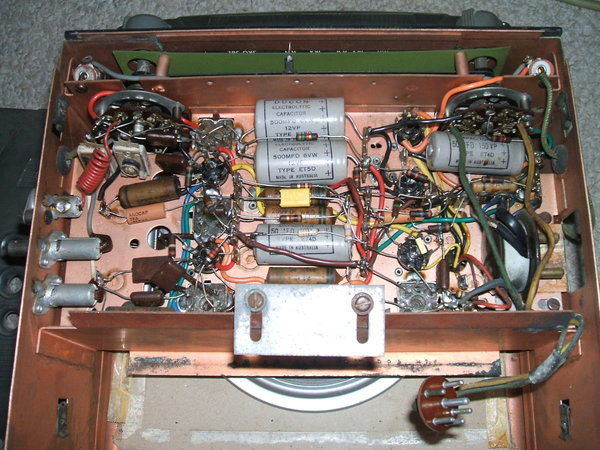
Ferris was a Sydney based company, established
in the 1930's who were synonymous with car radios. In later years they
became involved with television, releasing a local adaptation of a Raytheon
design, and locally manufacturing Channel Master TV aerials.
Ferris are most well known for a series
of portable car radios; radios which could operate off the car electrical
system, but then be taken out of the car and used at home on the mains
supply.

In the mid 1950's Ferris released their
model 106, a mains/battery portable radio. It looks like most other 1950's
battery valve portable radios, and as with many models around the
time, could operate off the mains. This was achieved by having the valve
heaters in series, thus drawing only 50mA which was well within the capabilities
of a typical valve rectifier. Because of the series heater connection,
the A battery for this kind of set is 7.5V, or 9V, depending whether or
not the set has an RF amplifier. Battery-only sets use an A battery of
1.5V with the heaters in parallel. Because of the much higher current draw
when connected this way; typically 250mA, it is much more difficult to
provide a hum free power supply from the mains, with the technology available
in the day. B+ is the usual 90V and typical current drain is 12mA.
The idea behind this was of course to
allow the set used off the mains when at home, saving the expensive batteries.
Because of the rarity of car radios in
Australia, many people used their portables in the car, but with the internal
loop aerial reception would not always be as good as that provided by an
external aerial.
The Ferris 106 portable was designed not
only as an ordinary portable with loop aerial, but to be used in a car
with a car radio aerial connection.



Power Supply
As can be seen, it is a typical mains
battery portable with 7 pin miniature valves. The valves are heated by
a 9V battery, and have 90V for the B+. When operating on the mains, the
6X4 provides about 105V at its cathode. This is dropped to 9V via R18,
a 2.3K 5W resistor for heating the valves. The approximate 90V B+ is supplied
via R17.
As with the other mains/battery sets made
by Ferris, the 240V input is via a two pin connector which accepts a standard
jug cord. This two pin connector is actually an HPM two pin plug with the
British round pin configuration. There is a metal strap which secures it
to the chassis. Earthing is by the side contact of the jug cord plug sliding
against the chassis.
RF Input.
An RF stage is provided using a 1T4. The
frequency converter is a 1R5 in a conventional circuit which then feeds
the 1T4 IF amplifier at 455Kc/s. A 1S5 provides detection and AGC from
its internal diode, and the audio is then amplified by the pentode section
prior to feeding the 3V4 output valve. So far it's all very conventional.
Where the 106 differs is with the RF input
stage. For normal portable use, the ferrite loopstick aerial, provides
the signal. S1b connects the loopstick to the input of the 1T4 RF amplifier
and tunes it with G1.

Note the copper plating. This provides superior shielding. Battery
plug is visible, bottom right.
Performance of the receiver is very good with ample sensitivity from the internal loopstick aerial. As the speaker is properly baffled, audio quality is also good, with a noticeably good bass response. My particular M106 was easy to restore with a few paper condenser replacements, and the speaker transformer which had an open primary. The latter was replaced with a Jaycar MM-1900 line transformer using the 1W (10K) tap.
Car Operation.
A car radio aerial socket is provided,
and when in car radio mode, the car aerial connects to aerial coil L2,
via ignition filter L1. Again, this is tuned by G1 and feeds the input
of the 1T4.
When at home, a long wire aerial can also
be connected if required. Now, the RF input becomes untuned. The signal
is fed to the 1T4 without any tuning. Given the high gain of the receiver
this is not a problem, and it does make the input less dependent of aerial
characteristics. The switch position for this is designated "Ferritenna".
The radio itself is unusual in that as
a portable it is constructed in a copper plated steel case and is well
shielded. Obviously, some thought went into optimising the in car operation.
For operating in a car, the radio can
be used off its internal battery pack in the normal way. However, that
becomes expensive for long term operation. Ferris thought of this problem
and so appeared the 30W
inverter which is described elsewhere on this site. The idea was
that the inverter would be mounted permanently in the car, and the 106
plugged in, just as it would be at home and run off 240V AC.

Other side of chassis. New speaker transformer is visible.

This ad from Radio Television & Hobbies, May 1960, shows Ferris
offloading remaining stock of the 106. The ad contains errors in that the
set did not receive short wave, and the model 107 was the inverter to power
the 106 from a 6,12, or 32V supply.